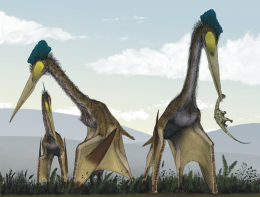October 18, 2010 report
10,000 miles: New study proposes giant Pterosaurs were record long-distance fliers

(PhysOrg.com) -- A new study suggests four species of ancient pterosaurs might have been able to soar as far as 16,000 km nonstop, making them the longest distance fliers in the Earth's history.
Researcher Michael Habib, a biomechanist at Chatham University, Pittsburgh in the US, has made new calculations on what he calls "supergiant" pterosaurs: four species of flying reptiles, including the Quetzalcoatlus northropi found in Texas. Dated to around 70 million years ago, these reptiles were about as tall as a modern giraffe and had a wingspan estimated at around 10 meters.
Habib and colleagues said that if the wingspan and body mass estimates were realistic and if the animals could catch thermals and glide like birds, he calculated they could have flown up to 16,000 km (10,000 miles) or more without needing to land. Their flight would have consisted of a few minutes of flapping at a time, followed by long periods of gliding with the help of thermals. If the calculations and the assumptions on which they are based are correct, this makes it possible that supergiant pterosaur fossils found on different continents might actually belong to the same species.
Habib’s calculations are based on estimates of body weight and wingspan taken from other researchers’ work. A pterosaur weighing 272 kg could fly 16,000 km without stopping using 72 kg of body fat as fuel for the long journey. He assumed a wing profile similar to an eagle’s, which is basically a transitional shape between long and narrow for gliding and wide for heavy lifting.
The calculations were conservative, using a modern atmosphere rather than the Cretaceous atmosphere, which was warmer and probably had more thermals to ride. A metabolic rate of 85 percent that of modern birds was assumed. Habib said even if different parameters are entered into the calculations the pterosaurs were still capable of flying long distances, with the lowest range estimate at 8,000 km, and the highest at 32,000 km. “What’s important is that the numbers are all big,” Habib said.
The research may contradict earlier findings that an animal as large as Quetzalcoatlus northropi would have been unable to take off, and could only have taken to the air by dropping off trees or cliffs. Habib said he was “pretty confident” pterosaurs would not have taken to the air like a bird, but suggested they could have launched themselves using all four limbs, as some modern bats do.
The research results were presented at the Society for Vertebrate Paleontology’s annual meeting last week.
© 2010 PhysOrg.com




















